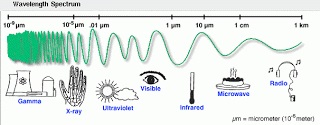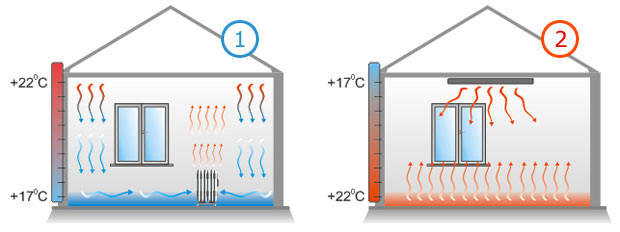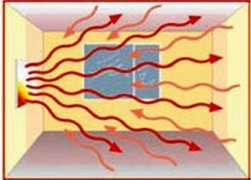Abstract
Содержание
Introduction
Infrared (IR) radiation occupies a plot of electromagnetic waves with wavelengths between 0.74 microns. (visible red light) and 100 microns. (short-wave radiation of radio frequency band).

Drawing 1 – Types of radiation
Infrared radiation is conventionally divided into:
- short-wave 0,74 < l < 2,5 mkm.
- medium-wave 2,5 < l < 50 mkm.
- long-wave 50 < l < 100 mkm.
We also should know that all bodies, solid and liquid, heated to a certain temperature are the source of infrared radiation.
IR is also called the "thermal" radiation as infrared radiation from the heated objects is perceived by the human skin as a feeling of warmth. Besides that, the wavelength, emitted by the body depends on the temperature of heating: the higher the temperature, the shorter the wavelength and higher radiation intensity. The emission spectrum of a black body at relatively low temperatures (up to several thousand K) lies mostly in this range. Infrared radiation emits activated atoms or ions. [1]
IR is almost the same as a regular light. The only difference is that after the contact with objects visible part of the spectrum turns into lighting, and infrared radiation is absorbed by the body, thus turning into heat energy. Life on our planet is inconceivable without it. By IR propagation through the space there is virtually no loss of energy. In fact, it's natural and the most perfect method of heating. Therefore, the question of using infrared radiation in heat and power engineering is very interesting.
1. INFRARED RAYS. TRANSPARENCY, REFLECTION, REFRACTION
Optical properties of materials in the infrared spectral region (transparency, reflectance, refraction index), are as a rule, significantly different from the optical properties in the visible and ultraviolet regions of the spectrum. Many substances, transparent in the visible region, are opaque in some areas of the IR-radiation. And vice versa. For example, the water layer thickness of a few cm is opaque to infrared radiation with l> 1 micron (water therefore is often used as a heat shield) and silicon and germanium plates, opaque in the visible region, are transparent to infrared radiation (germanium for l> 1,8 microns silicon for l> 1,0 microns). Black paper is transparent in the far infrared region. Substances that are transparent to IR radiation and opaque in the visible region are used as filters for the selection of infrared radiation.
The absorption of infrared radiation for most materials in thin layers is selective in relatively narrow areas - absorption bands. Some substances, mainly single crystals, even up to several cm thick are transparent in large enough certain ranges of IR spectrum. Reflectance to IR radiation of most metals is much more than the visible region, and it increases with the growth l IR. Liquid and solid non-metallic substances are in the infrared region of selective reflection, and the reflection position of the maxima depends on the chemical composition. [2]
Reflectance most metals to infrared radiation is much greater in comparison with visible light and increases as the wavelength of infrared radiation grows. For example: the reflection coefficient Al, Au, Ag, Cu when the wavelength of about 10 microns can reach 98%. The above materials are transparent to IR radiation, or have a high affinity with respect to their reflection and that are used to create infrared heaters.
The first type - are used as a "filter" (mostly quartz), the second type - are used for reflectors which enable direct infrared rays in a certain direction (mostly aluminum). [3]
The transparency of the atmosphere to infrared radiation (as well as for the visible and UV radiation) plays an important role in the process of thermal radiation exchange between the solar radiation incident on the Earth, and the Earth's infrared radiation into space (inverse radiation of the Earth is located mainly in the region of the spectrum with a maximum of approx. 10 microns) and is essential for practical use of infrared radiation (for communications, infrared images for use infrared radiation in military, etc.). Passing through the Earth's atmosphere, the IR radiation is attenuated by scattering and absorption. Nitrogen and oxygen of the air does not absorb IR radiation, and weaken it only as a result of scattering, which is significantly less than for visible light (since the scattering coefficient ~ l-4). Water vapor, CO2, ozone and other impurities present in the atmosphere, selectively absorb infrared radiation. Especially strongly absorb IR radiation, water vapor, the absorption bands of which are located in almost the entire infrared spectrum. Because of the strong absorption of infrared radiation of the earth's atmosphere, only a small part of the back of IR radiation beyond Earth's atmosphere, ie, the atmosphere acts as insulation wrapper that prevents cooling of the Earth. The presence of smoke particles in the atmosphere, dust, water droplets (mist, fog) leads to an additional weakening infrared radiation scattering by these particles, wherein the amount of scattering depends on the ratio of particle size and wavelength of IR radiation.
2. INFRARED HEATING
In today's world infrared devices are becoming more common. They are used in industry, public utilities, and medicine. In the propagation of infrared radiation in the space there is substantially no loss of energy. In fact, this is the natural and the most perfect method of heating. Radiant energy is absorbed by the surrounding surfaces, turning into heat energy, warms them, which in turn sends the heat to the air. The construction of heating system in high premises with high pedestrian flow using infrared emitters costs two times less than using water central heating systems.[4]
Infrared heating is a type of heating systems, where the infrared emitters are used as the heating source. Infrared heating can be used as an aid, and self-heating type. Due to the peculiarities of infrared radiation can be organized local heating, in which heat is applied only in those areas where it is needed, which is especially important in large rooms with high ceilings. In addition, it is the only form of heating, allowing to organize efficient heating of open spaces (including street).
Since the thermal radiation from the infrared heater is practically not absorbed or scattered by air, all the radiated energy reaches the right people and objects. Heated objects, in turn, transfer heat to the surrounding air. Therefore, infrared heating is called direct-fired heating and convection - indirect heating. This is the major difference of the infrared heaters from the other heating types. [5]

Drawing 2 – Infrared and convection heating
Infrared heater is a heating device that gives off warmth to the environment by means of infrared radiation. In everyday life, it is sometimes inaccurately called a reflector. Radiant energy is absorbed by the surrounding surfaces, turning into heat energy, warms them, which in turn sends the heat to the air. This provides a significant economic benefit compared with convection heating, where the heat is essentially spent on heating under-ceiling unused space. In addition, by means of infrared heaters possible is the local heating only of those areas of the premises in which it is needed, without heating the entire volume of the room; the thermal effect of infrared heaters is felt immediately after turning on, thus avoiding the pre-heating of the room. These factors reduce the costs of energy.

Drawing 3 – Distribution of infrared radiation from the heater
The main structural component of the infrared heater is an emitter, which emits infrared light by heating. In electric heaters is typically used a tubular electric heater (TEH) or open (or protected by a quartz tube) spiral, in gas - metal mesh or a tube with a black coating or ceramic plate with special holes, heated by passing it through the combustion of natural gas.[6]
For a directional heat and to protect the body and its contents from overheating is used a reflector, highly reflective and heat-resistant metal. If the radiator has a compact form, the reflector is made in the shape of paraboloid of revolution, if linear - parabolic cylinder. To mitigate and partial expansion pattern reflector sometimes make dull or cause bumps on it.
If the heater is designed to be located in a place accessible to people or pets, the emitter is additionally protected by the metal mesh or transparent partition.
Types of infrared heaters
Depending on the range of radiation, infrared heaters are divided into:
- Short-wave;;
- Medium-wave;
- Long-wave.
By type of energy source are distinguished::
- Electric;
- Gas;
- Diesel.
By the method of installation:
- Mobile (portable)
- Stationary - floor, wall, ceiling, suspended
Depending on the range of radiation and the energy source used, infrared heaters can be used for different purposes:
- Additional heating;
- Self-heating;
- Local (spot heating) in the room;
- Local heating outdoors;
- Heated outdoor events.
Ceramic infrared radiator
Ceramic infrared emitter consists of a resistive heating cable, fully immersed in a suitable ceramic material. Due to the complete immersion, the energy produced by the heating cable is passed to the material around him. This prevents overheating of the heating cable and increases its service life. The material used for laying the heating cable is non-conductive and must have good absorption and emission characteristics in the required infrared wavelength range. On the basis of these criteria produced ceramic infrared emitters with different geometries.
Ceramic infrared radiators are ceramic body, portion of the surface of which is used as a radiating surface with built-in heating coils. Moreover, ceramic IR emitters allow placing thermocouples stationary in the vicinity of the heating cable.
Ceramic infrared radiator was invented by Elstein-Werk. The basic model of a ceramic transducer with a screw cap patented March 24, 1949. Parallel to this has been developed flat ceramic infrared emitter, which allows to build a large infrared heating area. The patent for the flat ceramic infrared emitters has been granted to the company Elstein-Werk March 8, 1950.
Infrared gas heater is a kind of thermal equipment, heater used to warm up the objects and space heating by infrared radiation.
The main indicator of the energy efficiency of gas-fired infrared heater is a radiant efficiency. The indicator of the radiant efficiency shows the percentage of energy converted into thermal radiation reaching the heated zone. Modern gas-fired infrared heaters reach produced radiant efficiency - 80%.
Getting back to Earth, the thermal radiation from the sun heats the surface: soil, rocks, trees, water, etc. and only then after the contact with them is heated air.
Infrared heaters work the same. Usually being located in areas at a height of 4 to 32 meters, they are like a little sun, directing the warm rays downward. Room is heated by the direct exposure of infrared rays on the surface: the floor, the lower zone of the exterior walls, equipment, and people. [7]
They absorb heat first, and only then from a hot surface, the process of heat transfers to the surrounding air. This is the principle of infrared heaters, and the very essence of infrared heating. In this method of heating the surface of objects is warmer than the surrounding air by 7-10 C.
The main elements of the design of a gas infrared heater are:
- The case in which the gas and air are mixed to form a gas-air mixture;
- Perforated refractory ceramic tiles on the outside surface of which the mixture is burned.
One of the structural varieties of gas infrared heaters that use the same principle of radiant heat, are tubular gas infrared heaters, the main elements of the design are:
- the blow torch, in which the gas and air are mixed to form a gas-air mixture;
- radiant metal tubes, inside which the combustion of the mixture occurs.
The first gas infrared heater was invented and patented in 1933 by German designer Gunther Schwank (today his name is the world's largest manufacturer of infrared gas equipment - the company Schwank).
Air-gas radiant heating
In the gas-heating system with radiators function of heaters perform radiant pipes laid in the upper zone (above 5 m above the floor) room. Inside the closed-loop radiant tubes circulates heated air mixture with the combustion products. Heat transfer from the surface of the pipes into the room is done predominantly through the radiation (up to 60%).
The advantages of gas-radiant heating in comparison with air heating: heat savings by reducing the temperature gradient along the height of the room, the ability to reduce the temperature of the air in the work area while maintaining the conditions for thermal comfort, autonomy, non-freezing, ease of regulation.
Gas radiant heating
Heating devices in this system of heating are infrared radiant burner. Radiant heating system is most appropriate to use in large rooms with significant heat loss. It is especially effective in heating partially or completely open work areas (installation, assembly, open car parking, etc.). The small size and weight of the infrared burners make them easy to place in the heated rooms. Their heat-transferring surface is by almost 10 times smaller than the heating surface area of the heaters in hot-water heating. Gas radiant heating is also used in various agricultural and warehouses. [8-11]
References
- З.Дене Инфракрасное излучение, Стройиздат, 1965
- М.А.Брамсон Инфракрасное излучение нагретых тел, «Наука», 1964
- П.Краус, Л.Макглоулин, Р.Макквистан Основы инфракрасной техники, Воениздат, 1964
- М.Дерибере Практика применения инфракрасных лучей, Госэнергоиздат, 1959
- Р.Борхерт, Б.Юбиц Техника инфракрасного нагрева. Госэнергоиздат, 1963
- Б.С.Ициксон, Ю.Л.Денисов Газовые инфракрасные излучатели и их использование в народном хозяйстве, «Недра», 1965
- Ж.Леконт Инфракрасное излучение Издательство физико-математической литературы, 1958
- А.А. Богомолов, Д.Я. Вигдорчик, М.А.Маевский Газовые горелки инфракрасного излучения - Москва: Издательство литературы по строительству – 1967, 255 с.
- П.Б.Майзельс, Д.Я. Вигдорчик Газогорелочные устройства, Стройиздат, 1964
- А. Миссенар Лучистое отопление. Госстройиздат, 1961
